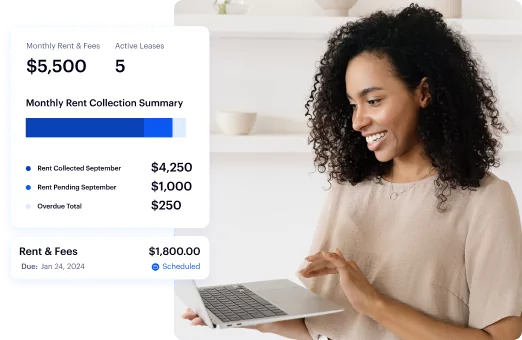As a landlord or property manager, efficiently collecting rent is fundamental to your success. Traditional methods like paper checks often lead to delays, manual reconciliation, and increased administrative burdens.
In 2025, Automated Clearing House (ACH) payments stand out as a secure, cost-effective, and streamlined solution for modern rent collection. Understanding the best way to collect rent online and refining your rent collection methods can significantly boost your operational efficiency.
Key takeaways
- ACH payments leverage a secure electronic network for direct bank-to-bank transfers.
- They offer landlords significant benefits including cost efficiency, enhanced security, and automation for recurring payments.
- Setting up ACH for rent collection involves choosing a reliable provider and ensuring proper tenant authorization.
- Despite advantages, landlords should understand typical processing times and strategies for managing failed payments.
- Baselane provides a comprehensive solution for managing ACH rent payments seamlessly, helping landlords take back time and gain clarity.
What is the Automated Clearing House ACH Network?
The Automated Clearing House (ACH) Network is a secure electronic funds transfer system overseen by Nacha, a private-sector organization. It facilitates a wide range of electronic payments, including direct deposits, bill payments, and interbank transfers. This network moves billions of transactions annually, underpinning a significant portion of the U.S. financial system.
Nacha sets the rules and regulations for ACH payments, ensuring their efficiency, reliability, and security. In Q1 2025, overall ACH payment volume rose 4.2% to 8.5 billion transactions, with value up 6.6% from the previous year, demonstrating strong growth in the network, according to Nacha (2025). This consistent growth highlights the network’s increasing adoption and importance in the digital payment landscape.
How ACH payments work for rent collection
For landlords, leveraging ACH streamlines the rent collection process by facilitating direct transfers from a tenant’s bank account to yours. The process typically involves several key steps. First, the landlord obtains authorization from the tenant, usually through a signed agreement or an online portal. This authorizes the landlord or their payment processor to initiate debits from the tenant’s bank account via ACH.
Next, the landlord or their chosen payment provider initiates the payment request, specifying the amount and due date. This request is then transmitted through the ACH network to the tenant’s bank for validation and settlement.
Funds are typically transferred within 1-3 business days. Once settled, the funds are credited to the landlord’s account, and both parties receive confirmation. This systematic approach allows landlords to efficiently receive ACH payments directly into their designated accounts.
ACH vs. other rent payment methods
Choosing the right rent payment method is essential for efficiency and security. While various options exist, ACH payments often provide distinct advantages. Let’s compare ACH with other common payment types to highlight why many landlords prefer it.
| Feature | Baselane (ACH via Baselane) | Traditional ACH (via bank/basic service) | Credit/Debit Card Payments | Peer-to-Peer Apps (e.g., Venmo, PayPal) | Checks/Money Orders |
|---|---|---|---|---|---|
| Transaction Fees (Landlord) | No monthly fees (for ACH) | Low ($0.25 – $1.50 per transaction) | Higher (2.5% – 3.5% of rent) | Variable, can be high for business/large sums | Low (cost of check/envelope, time) |
| Transaction Fees (Tenant) | No fees (for ACH) | Often passed to tenant | Often passed to tenant | Often passed to tenant | None directly |
| Settlement Time | 1–3 Business Days | 1–3 Business Days | 1–2 Business Days | Instant to 1–3 Business Days | Days to weeks |
| Automation & Recurring | Yes, seamless setup | Yes, if offered by bank/service | Yes, if offered by platform | Limited/less user-friendly for recurring | No |
| Security & Fraud Protection | High (Bank-level encryption, fraud monitoring, integrated) | High (Bank-level encryption, fraud monitoring) | High (Card network protection) | Varies, less robust for rent | Low (prone to loss/theft) |
| Ease of Setup (Landlord) | Very Easy, integrated platform | Moderate, may require bank setup | Easy, through payment processor | Easy, but often manual | Very Easy (physical process) |
| Ease of Use (Tenant) | Very Easy, dedicated portal | Easy, via landlord’s portal | Easy | Very Easy | Moderate (manual process) |
| Integration with PM Tools | Full Integration (Banking, Accounting, Rent Collection) | Limited / Requires manual entry | Varies by processor | None (manual tracking/export) | None (manual tracking) |
| Guaranteed Payments | Not guaranteed, but platform emphasizes reliability | No, typically | Yes, but with chargeback risk | No | No |
When comparing ACH vs wire transfer, ACH is typically used for recurring, lower-value transactions, while wire transfers are for high-value, urgent, one-time payments. Credit and debit cards offer instant payment confirmation but come with higher processing fees, often passed onto the tenant.
Understanding how to pay rent with a credit card is important, but these fees can deter tenants. Peer-to-peer apps like Venmo or PayPal are convenient but lack the robust features and protections necessary for formal rent collection. Checks and money orders are slow, prone to loss, and require manual processing, making them inefficient for landlords.
Why landlords choose ACH for rent collection
ACH payments offer a suite of advantages that can significantly enhance a landlord’s operational efficiency and financial stability. These benefits range from substantial cost savings to improved tenant satisfaction. Embracing ACH can transform your rent collection process.
Cost efficiency
One of the most compelling reasons for landlords to adopt ACH payments is their cost-effectiveness. ACH transactions are typically 50-70% cheaper for landlords compared to credit card transactions, making them a highly cost-effective option.
This significant reduction in processing fees directly translates to higher net income for your rental business. Many payment solutions even offer no-cost ACH options for landlords.
For example, traditional credit card processing can charge 2.5% to 3.5% of the rent amount. For a $1,500 monthly rent payment, this could mean $37.50 to $52.50 per transaction. In contrast, ACH fees are often flat and minimal, sometimes less than a dollar, or even no cost at all. This difference can accumulate into substantial savings, especially for landlords with multiple properties.
Enhanced security and reliability
The ACH network is built with robust security measures to protect financial data. Transactions are encrypted and processed through secure banking channels, reducing the risk of fraud compared to paper checks.
Unlike credit card numbers that expire every three years, U.S. adults maintain the same primary checking account for over 17 years on average, making bank account details more durable for recurring payments. This stability reduces the need for frequent payment information updates, minimizing disruptions.
Furthermore, the digital nature of ACH payments eliminates the risks associated with physical checks, such as mail theft or manual alteration. Each transaction is recorded electronically, providing a clear audit trail. This inherent reliability enhances the security profile of your rent collection process.
Convenience and automation
ACH payments excel in their ability to automate recurring rent collection. Once authorized, rent payments can be debited automatically on the due date, eliminating the need for manual intervention each month. This feature provides landlords with consistent and predictable cash flow. Automated invoicing and reminders further simplify the process.
This automation is a significant time-saver, reducing the administrative burden on landlords. Setting up automatic rent collection minimizes late payments by ensuring funds are transferred promptly. Landlords can also manage ACH billing for other recurring expenses related to their properties.
Improved cash flow management and predictability
The predictable nature of ACH payments greatly assists landlords in managing their cash flow. ACH transfers usually settle within 1-3 business days, providing a quick and reliable way for landlords to manage cash flow, with growing availability of same-day and instant ACH options. This reliable settlement time allows for accurate financial forecasting and budgeting.
Knowing exactly when rent payments will arrive helps landlords cover property expenses, mortgage payments, and other financial obligations on time. The consistent influx of funds through ACH payments removes the uncertainty often associated with traditional methods. This predictability is invaluable for effective financial planning and growing passive income.
Tenant satisfaction and retention
Tenants today expect convenient, digital payment options. According to Multifamily Dive and Zillow, 8 in 10 tenants express a desire to pay rent online without incurring service fees, and 69% prefer online rent payments. Offering ACH aligns with these modern preferences, enhancing tenant satisfaction. Providing a seamless, no-fee online payment experience can be a strong selling point for your rental units.
Companies that absorb ACH processing fees for residents see an average digital payment utilization rate of 84.71%, significantly higher than the 47% utilization rate when fees are passed to tenants. This data suggests that offering fee-free ACH payments directly improves tenant adoption of digital payments. Satisfied tenants are more likely to renew leases, contributing to higher retention rates.
How to set up ACH rent payments: a landlord's step-by-step guide
Implementing ACH payments for your rental properties can significantly streamline your operations. The process involves selecting the right platform and guiding your tenants through the setup. Follow these steps to begin accepting ACH rent payments.
Choosing an ACH payment provider or property management software
The first step is to choose a reliable ACH payment provider or property management software that integrates ACH capabilities. Many platforms offer this service, but it’s crucial to select one designed specifically for landlords. Look for features like automated rent reminders, secure tenant portals, and comprehensive financial reporting.
Consider a [property management software online rent payment] system that offers integrated banking and bookkeeping. This type of solution simplifies your financial management by consolidating all transactions in one place. Choosing a robust [rent payment solution] designed for landlords ensures seamless operations. Many platforms also offer a [free rent collection app] with basic ACH features, which can be a great starting point for landlords with a few units.
Account verification and setup
Once you’ve selected a provider, you’ll need to set up your landlord account and link your bank account. This typically involves providing your banking details, such as routing and account numbers, to the chosen platform.
The platform will then verify your bank account, often through micro-deposits, to ensure accuracy and security. Understanding [ach payment setup] and what you need to know about bank account ACH details is key for smooth integration.
For platforms like Baselane, setting up your banking solution and linking accounts is designed to be straightforward. This step is critical for ensuring that rent payments are correctly routed to your designated operating accounts. The verification process protects both you and your tenants.
Inviting tenants and managing payments
After your account is set up, you can invite your tenants to register on the platform. They will then provide their banking information to authorize recurring ACH debits for rent payments. Most platforms offer a user-friendly tenant portal where they can manage their payment methods and view payment history.
Once tenants authorize payments, the system handles the rest, sending automated reminders and processing payments on the due date. This automation reduces your administrative burden and improves on-time payments. You will receive notifications for successful payments and any exceptions.
Common challenges and concerns with ACH payments
While ACH payments offer numerous advantages, landlords should be aware of potential challenges. Understanding these issues and how to address them ensures a smoother rent collection process. Proactive measures can mitigate the most common concerns.
ACH transfer times and processing
One common concern for landlords is the processing time for ACH payments. Standard ACH transfers usually settle within 1-3 business days. While generally quick, this is not instantaneous like a credit card transaction. Landlords should account for these processing times in their cash flow planning.
Some advanced platforms offer same-day ACH or instant ACH options, which can further expedite fund availability. However, these options might come with additional fees. It’s crucial to understand the typical settlement period provided by your chosen payment processor to set realistic expectations for rent payment receipt.
Dealing with Failed Payments and Insufficient Funds
Occasionally, an ACH payment may fail due to insufficient funds (NSF), incorrect bank information, or a stopped payment order. When an ACH payment fails, the payment processor will notify both the landlord and the tenant. You will typically incur a return fee from the bank. It’s important to have a clear policy in your lease agreement regarding failed payments and associated fees.
Effective strategies for landlords include automated notifications for failed payments and a system for collecting late fees. Communicating promptly with tenants about the issue helps resolve it quickly. Some platforms offer features to retry failed payments automatically, though usually after a waiting period.
Automate rent, deposits, and fees for reliable on-time payments.
Privacy and security best practices for both parties
Maintaining privacy and security is paramount when handling financial information. Landlords should only use reputable payment processors that employ bank-level encryption and comply with industry security standards. Never ask tenants to email sensitive banking details. Tenants should also ensure they are using a secure, dedicated tenant portal.
For landlords, this includes protecting your own banking information and login credentials for the payment platform. Regularly monitor your accounts for any suspicious activity. Implementing two-factor authentication for platform access is also a strong security measure for both landlords and tenants.
Legal considerations
The legality of requiring tenants to pay rent via ACH varies by jurisdiction. While convenient for landlords, some states or municipalities have laws protecting a tenant’s right to pay rent by traditional methods like check or cash. It is crucial to be aware of and comply with local landlord-tenant laws.
In many areas, landlords cannot legally mandate electronic payments as the sole option. However, offering ACH as a preferred, incentivized, or primary option is usually permissible. Always consult local housing authorities or legal counsel to ensure your rental agreements and payment policies are compliant with all applicable regulations.
Real-world trends and Statistics for ACH payments
The adoption of ACH payments is steadily growing, reflecting a broader shift towards digital financial transactions. This trend is particularly evident in the rental industry, where landlords and tenants increasingly favor electronic methods for their efficiency and security. Recent statistics from 2025 underscore this growth.
Growth in ACH Transaction Volume and Value
The ACH network continues to expand, demonstrating its pivotal role in the U.S. economy. In Q1 2025, overall ACH payment volume rose 4.2% to 8.5 billion transactions, with value up 6.6% from the previous year, according to Nacha (2025). This sustained growth signifies the network’s increasing reliability and acceptance across various sectors, including real estate.
The Clearing House’s ACH Network reported a 6.2% increase in transaction volume in April 2025 (Alta, 2025). This further illustrates the robust expansion of electronic payments. These figures highlight a clear trend: ACH is not just a passing fad but a foundational element of modern financial operations for businesses and individuals alike.
Quantifiable cost savings data for landlords
The cost-efficiency of ACH payments offers tangible savings for landlords. ACH payments are typically 50-70% cheaper for landlords compared to credit card transactions. This significant cost reduction directly impacts a landlord’s bottom line. For instance, a landlord managing ten properties with an average rent of $1,500 could save hundreds or even thousands of dollars annually on transaction fees by switching from credit card payments to ACH.
These savings free up capital that can be reinvested into property maintenance, upgrades, or portfolio expansion. Minimizing operational costs is a key strategy for maximizing profitability in real estate. The financial benefits make ACH an attractive option for forward-thinking landlords.
Tenant Adoption Rates and Preferences
Tenant demand for convenient, digital payment options is strong and growing. 8 in 10 tenants desire to pay rent online without incurring service fees, and 69% prefer online rent payments. This indicates that offering a seamless ACH payment option directly caters to tenant preferences, potentially increasing tenant satisfaction and retention.
Furthermore, companies absorbing ACH processing fees achieve a digital payment utilization rate of 84.71%, significantly higher than the 47% rate when fees are passed to tenants. This data emphasizes the importance of a landlord-friendly, no-fee ACH solution. Providing tenants with an easy and free way to pay rent online boosts adoption rates and makes rent collection smoother for everyone.
Maximizing your rent collection with Baselane ACH payments
Baselane is designed to simplify and enhance the rent collection process for landlords through its integrated financial platform. Our solution makes accepting ACH payments seamless and cost-effective, helping you reclaim valuable time and gain clearer financial insights. By leveraging Baselane, you can centralize your banking, bookkeeping, and rent collection, all under one roof.
With Baselane, you can set up automated rent invoices and reminders, ensuring timely payments from your tenants. Our platform handles the ACH payment process securely, depositing funds directly into your Baselane Banking accounts. This integration helps you streamline rent collection and reduces manual reconciliation efforts. The average investor saves 150 hours per year using Baselane.
Beyond basic rent collection, Baselane offers tools that support comprehensive financial management. You can manage ACH for accounts payable, ensuring your property expenses are paid efficiently. Baselane’s flexible rent collection features allow for handling specific tenant needs, such as split rent payments or flex rent payments, making it easier for tenants to pay.
You can also manage instances of partial rent payment and automate the calculation of late fees. For new tenants, Baselane can assist with understanding how does prorated rent work and applying rent concessions if necessary. In cases where issues arise, our tools provide the financial visibility needed to handle situations like how to collect unpaid rent after a tenant moves out. Baselane centralizes your financial data, helping you make smarter decisions and grow your rental property business.
Bottom line
Adopting Automated Clearing House (ACH) payments is a strategic move for any landlord or property manager aiming for a more efficient, secure, and cost-effective rent collection process in 2025 and beyond. ACH provides unparalleled reliability and automation, freeing you from the manual burdens of traditional payment methods. By embracing this technology, you can significantly improve your cash flow predictability, reduce administrative overhead, and enhance tenant satisfaction.
Choosing a robust, integrated platform like Baselane can further amplify these benefits. Our banking solution enables landlords to collect rent seamlessly, manage expenses, and gain comprehensive financial clarity, all with no monthly fees. Take control of your rental finances, save time, and empower your growth by integrating ACH payments into your property management strategy today.
FAQs
An ACH payment for landlords is an electronic funds transfer from a tenant's bank account directly to the landlord's bank account via the Automated Clearing House network. It's a secure and efficient way to collect rent payments.
Standard ACH rent payments typically process and settle within 1-3 business days. Some payment platforms may offer faster options like same-day ACH for an additional fee.
Yes, collecting rent via ACH is generally considered very safe. The ACH network employs robust security protocols and encryption to protect sensitive financial data during transactions.
The ability for a landlord to legally require ACH payments as the sole method varies by state and local regulations. While many landlords offer it, some jurisdictions protect a tenant's right to pay via traditional methods like checks.
If an ACH rent payment fails due to insufficient funds or incorrect information, the landlord and tenant are typically notified. The landlord may incur a return fee from their bank, and they can then work with the tenant to resolve the outstanding payment, often with applicable late fees.








